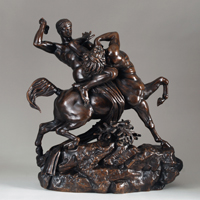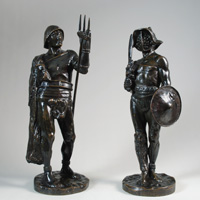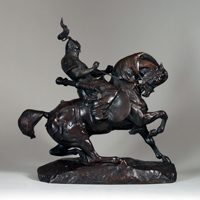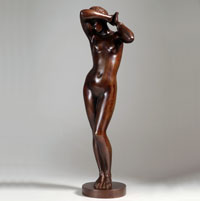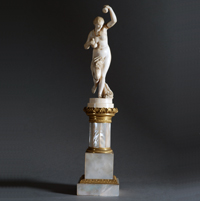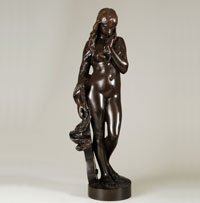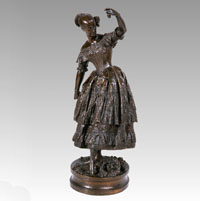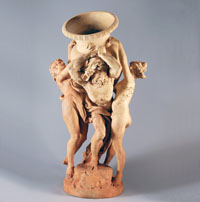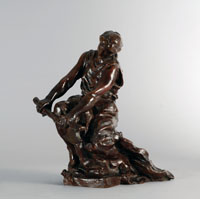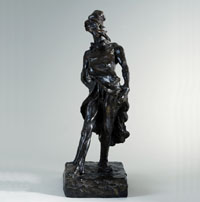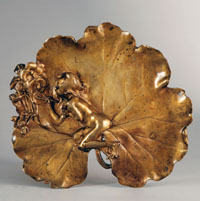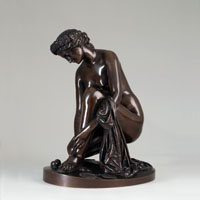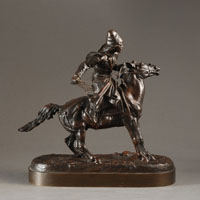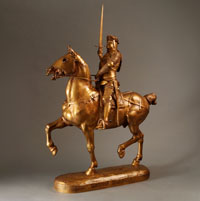19th century sculpture is particulary well-represented in the gallery by one of its components : that of les animaliers, or the Animalists - Barye, Isidore and Rosa Bonheur, Fratin, Mëne, Moigniez - of whom about a hundred pieces are featured on permanent display.
Michel Poletti and Alain Richarme are renowned experts on the works of Antoine-Louis Barye, of which they have just completed an extensive catalogue. Catalogue raisonné des sculptures de Barye, (Gallimard, 2000). Other figures of the 19th century are also very present, including works by Feuchère, Gechter, Pradier, Clésinger, and Rude - all great examples of Romanticism and Neoclassicism.
The gallery has a particular interest in the lively works of Jean-Baptiste Carpeaux, and has published a catalogue of the artist's work, Jean-Baptiste-Carpeaux sculpteur, Catalogue raisonné de l'oeuvre édité, (Amateur 2002).
The gallery's 19th century colleciton also features the terracotta pieces of Carrier-Belleuse, gushing with creativity, the symbolist works of Bartholomé, the realisme of Dalou...
19th Century Sculpture
Jean-Baptiste Carpeaux (1827–1875)
Carpeaux was born in Valenciennes on May 11th 1827. As a young man, he studied at the local Académie de Peinture et Sculpture. His family moved to Paris where Carpeaux learnt under Rude from 1844 to 1850. The great influence of Rude’s approach to naturalism in sculpture drove Carpeaux to cut deliberately adrift from his master in 1850. Carpeaux won the Prix de Rome in 1854, whereupon he moved to the great Italian capital to find inspiration. There, he studied the works of Michelangelo, Donatello, and Verrocchio. Staying in Rome from 1854 to 1861, he obtained a taste for movement and spontaneity, which he joined with the great principles of baroque art. Carpeaux established his reputation with Ugolino and his Sons (1861), a dramatic bronze for the Tuileries Gardens, Paris. Also in 1861, he sculpted a bust of the Princess Mathilde. This work later brought him several commissions from Napoleon III. Carpeaux worked at the pavilion of Flora, and the Opéra Garnier. His group "La Danse" (Dance, 1869), situated on the right side of the façade, was criticised as an offence to common decency. It created a sensation and was attacked as immoral. Carpeaux never managed to finish his last work, the famous "Fountain of the Four Parts of the Earth", on the Place Camille Jullian. Carpeaux did finish the terrestrial globe, supported by the four figures of Asia, Europe, America and Africa, and it was Emmanuel Frémiet who completed the work by adding the eight leaping horses, the tortoise and the dolphins of the basin. Carpeaux died in Courbevoie on October 12th 1875.
Bibliography
BRAUNWALD, Annie & HARDY, André, Dessin de Jean-Baptiste Carpeaux à Valenciennes, Valenciennes, 1975.
CARPEAUX, Charles, La Galerie Jean-Baptiste Carpeaux, 1ère série avec un préface de Gustave Geffroy, Paris, P. Ollendorf, 1899.
CHESNEAU, Ernest, Le Statuaire Jean-Baptiste Carpeaux, sa vie et son œuvre, Paris A.Quantin, 1880.
CLARETIE, Jules, J.-B. Carpeaux 1827-1875, Paris, sans date
CLEMENT-CARPEAUX, Louise, La Vérité sur la vie et l'œuvre de Jean-Baptiste Carpeaux (1827-1875), tombe I, Paris, ed Dousset et Bigerelle, 1934 ; tombe II, ed Nemours, A. Lesot, 1935 (Sigle : LCC)
DE MARGERIE, L. La Danse de Carpeaux, Les dossiers du musée d'Orsay, 1989.
HARDY, A. et BRAUNWALD, A., Catalogue raisonné des peintures et sculptures de J.-B. Carpeaux à Valenciennes, 1978.
JEANCOLAS, Claude, Carpeaux sculpteur et peintre, Lausanne, Edita Lazarus, 1987.
JOUVENET, Nicole, Jean-Baptiste Carpeaux, Coondé-su-l'Escaut, Carlo-Descamps, 1974.
KOCKS, Dirk, Jean-Baptiste Carpeaux. Rezeption und Originalität, St.Augustin, ed Richarz, 1981
LECOMTE, Georges, La Vie héroïque et glorieuse de Carpeaux, Paris, Plon, coll. "Le roman des grandes artistes", 1928.
LEGRAND, Louis, Carpeaux. Discours prononcé sur la tombe, le 29 novembre 1875, Valenciennes, ed Giard, 1875.
LOVETT, J.G., A romance with realism, the art of J.-B. Carpeaux, 1989.
MABILLE DE PONCHEVILLE, André, Carpeaux inconnu, ou la tradition recueilli, Paris- Bruxelles, G. Van Oest & Cie, 1921.
MARGUERITTE, Victor, Carpeaux (1827-1875), Paris, P.Iribe, 1914.
MAXE, V., J.-B. Carpeaux, 1989.
MUSEE DES BEAUX-ARTS DE NICE, Jean-Baptiste Carpeaux, Nice, 1989.
MUSEE ROYBET-FOULD, Carpeaux, Courbevoie, sans date.
PARMENTIER, Florian, J.-B. Carpeaux, Paris, 1919.
POLETTI, Michel et RICHARME, Alain, Jean-Baptiste Carpeaux sculpteur, catalogue raisonné de l'œuvre édité, Paris, Univers du Bronze, 2003.
Bibliography
GALERIE MICHEL BERTRAN, A.-E. Carrier-Belleuse, sculpteur, 2002.
Bibliography
MUSEE DES BEAUX ARTS DIJON, Emmanuel Frémiet, La main et le multiple, 1988.
BIEZ, Jacques de, Un maître imagier, E. Frémiet, 1896.
FAURE-FREMIET, Les maîtres de l'art, Frémiet, 1934
Bibliography
Musée du Luxembourg, Paris, Rodin en 1900 l'exposition de l'Alma, 2001.
DAIX, P. Rodin, biographie, 1988.
GOLDSCHEIDER, C., Rodin inconnu, exposition, 1962.
LE NORMAND, A. ,Le Baiser de Rodin, 1995.
PINGEOT, A., Le corps en morceaux, 1990.
CLADEL, J., Auguste Rodin l'oeuvre et l'homme, 1908.
GRAPPE, G., Catalogue du Musée Rodin, 1938.
RILKE, R. M., Auguste Rodin, 1928.
CHAMPIGNEULLE, B., Rodin, 1967.
TANCOCK, J. L., The sculpture of Auguste Rodin, 1976.
GIANADDA, P. GASSIER, P., Rodin, 1984.
JARRASSE, D., Rodin, la Passion du Mouvement, 2001.
GOLDSCHREIDER, C., Rodin, sa vie, son oeuvre, tome 1, 1989.
APPEL, Th. FOULON, P-J., Auguste Rodin, Die Bürgervon Calais - Werk und Wirkung, 1997.
Musée Rodin, Rodin et la sculpture contemporaine, colloque, 1982.
LE NORMAND, A., 1898 : le Balzac de Rodin, 1998.
BUTLER, R., Rodin, la solitude du génie, 1998.
BENEDITE, L., Rodin, 1926.
BARBIER, N. VILAIN, J., Rodin sculpteur, œuvres méconnues, 1993.
COQUIOT, G., Rodin à l'hôtel de Biron et à Meudon, 1917.
GOLDSCHEIDER, L., Rodin sculptures, 1970.
BARBIER, N., Marbres de Rodin, 1987.
MUSEE GUPIL BORDEAUX, Figures d'ombres, les dessins de Auguste Rodin, 1996.
PINET, H., Rodin sculpteur et les photographes de son temps, 1985.
Bibliography of Fratin
BOUGON, Jaqueline, Le Sculpteur animalier Christophe Fratin. Essai sur sa vie et sur son œuvre. Le Raincy, (sans indication d'éditeur), 1983.
POLETTI, Michel et RICHARME, Alain, Inventaire des œuvres de Fratin, Paris, Editions Univers du Bronze, 2000.
POLETTI, Michel et RICHARME, Alain, Fratin. Catalogue Raisonné, Paris, ed Gallimard, 2000.
VICTOR FRANSES GALLERY, The bear bronzes of Christophe Fratin, 2002.
Bibliography
BRAUNWALD, Annie & HARDY, André, Dessin de Jean-Baptiste Carpeaux à Valenciennes, Valenciennes, 1975.
CARPEAUX, Charles, La Galerie Jean-Baptiste Carpeaux, 1ère série avec un préface de Gustave Geffroy, Paris, P. Ollendorf, 1899.
CHESNEAU, Ernest, Le Statuaire Jean-Baptiste Carpeaux, sa vie et son œuvre, Paris A.Quantin, 1880.
CLARETIE, Jules, J.-B. Carpeaux 1827-1875, Paris, sans date
CLEMENT-CARPEAUX, Louise, La Vérité sur la vie et l'œuvre de Jean-Baptiste Carpeaux (1827-1875), tombe I, Paris, ed Dousset et Bigerelle, 1934 ; tombe II, ed Nemours, A. Lesot, 1935 (Sigle : LCC)
DE MARGERIE, L. La Danse de Carpeaux, Les dossiers du musée d'Orsay, 1989.
HARDY, A. et BRAUNWALD, A., Catalogue raisonné des peintures et sculptures de J.-B. Carpeaux à Valenciennes, 1978.
JEANCOLAS, Claude, Carpeaux sculpteur et peintre, Lausanne, Edita Lazarus, 1987.
JOUVENET, Nicole, Jean-Baptiste Carpeaux, Coondé-su-l'Escaut, Carlo-Descamps, 1974.
KOCKS, Dirk, Jean-Baptiste Carpeaux. Rezeption und Originalität, St.Augustin, ed Richarz, 1981
LECOMTE, Georges, La Vie héroïque et glorieuse de Carpeaux, Paris, Plon, coll. "Le roman des grandes artistes", 1928.
LEGRAND, Louis, Carpeaux. Discours prononcé sur la tombe, le 29 novembre 1875, Valenciennes, ed Giard, 1875.
LOVETT, J.G., A romance with realism, the art of J.-B. Carpeaux, 1989.
MABILLE DE PONCHEVILLE, André, Carpeaux inconnu, ou la tradition recueilli, Paris- Bruxelles, G. Van Oest & Cie, 1921.
MARGUERITTE, Victor, Carpeaux (1827-1875), Paris, P.Iribe, 1914.
MAXE, V., J.-B. Carpeaux, 1989.
MUSEE DES BEAUX-ARTS DE NICE, Jean-Baptiste Carpeaux, Nice, 1989.
MUSEE ROYBET-FOULD, Carpeaux, Courbevoie, sans date.
PARMENTIER, Florian, J.-B. Carpeaux, Paris, 1919.
POLETTI, Michel et RICHARME, Alain, Jean-Baptiste Carpeaux sculpteur, catalogue raisonné de l'œuvre édité, Paris, Univers du Bronze, 2003.
Albert-Ernest Carrier-Belleuse (1824-1887)
His handling of terracotta, in works such as the Nymph with three Amorini is one of his most innovative technical contributions to contemporary sculpture. Carrier-Belleuse developed a method to keep the terracotta partly moist during the firing process in order to add delicate modelling, which gave each cast the impression of a freshly modelled work. Carrier-Belleuse ran an efficient and controlled studio which maintained his high standards of craftsmanship. An efficient studio, however, is nothing without the artistic inspiration and style needed to satisfy the constant demand for elegant, yet individual models. This Carrier-Belleuse provided throughout his career, forever inventing and re-inventing attractive commercial models.
Bibliography
GALERIE MICHEL BERTRAN, A.-E. Carrier-Belleuse, sculpteur, 2002.
Aimé-Jules Dalou (1838–1902)
Jules Dalou studied in Paris, where he was born on December 31st 1838, under Jean-Baptiste Carpeaux and François-Joseph Duret. Carpeuax combines the vivacity and the richness of the first with the academy purity and scholarship of the latter. Admired for his perceptiveness, execution and arrangement, Dalou is recognized as one of the most brilliant virtuosos of the French school. Dalou first exhibited at the Paris Salon in 1867. But with the Franco-Prussian war and the troubles of the Commune in Paris in 1871, he took refuge in England, where he easily made a name for himself through his appointment at South Kensington. In England, Dalou laid the foundation for the great improvements which resulted in the development of the modern British school of sculpture. At the same time, Dalou executed a remarkable series of terracotta statuettes and groups, such as A French Peasant Woman (of which a bronze version under the title of Maternity was erected outside the Royal Exchange) and the groups of two Boulogne women called The Reader and a Woman of Boulogne telling her Beads. Returning to France in 1879, he produced a number of masterpieces. Exhibited in 1883, his great relief of Mirabeau replying to M. de Dreux, and the highly decorative panel, Triumph of the Republic, exhibited later at the Palais Bourbon, were followed in 1885 by The Procession of Silenus. For the city of Paris he executed the vast monument, The Triumph of the Republic, his most elaborate and splendid achievement, erected, after twenty years of work, in the Place de la Nation. The statue is a symbolical figure of the Republic, aloft on her chariot drawn by lions, and led by Liberty, attended by Labour and Justice, and followed by Peace. It was somewhat in the taste of the Louis XIV period, ornate, but exquisite in every detail. Within a few days there followed the inauguration of his great Monument to Alphand (1899), which almost equalled the success achieved with the monument to Delacroix in the Luxembourg Gardens. Another of his famous works adorns the grave of Victor Noir at Père Lachaise Cemetery in Paris. Dalou was awarded with the Grand Prix of the Exposition Universelle in 1889; was made an officer of the Legion of Honour; and was one of the founders of the New Salon (Société Nationale des Beaux-Arts), where he was the first president of the sculpture section. In portraiture, whether statues or busts, his work is no less remarkable. On April 15th 1902, Jules Dalou died. He was interred in the Cimetière du Montparnasse in Paris.
Alfred Dubucand (1828-1894)
Dubucand was a pupil of Lequien and Barye. Dubucand exhibited regularly at the Salon between 1867 and 1883. Dubucand was a prolific animalier sculptor and an impressively realistic modeller who attempted a considerable variety of subjects. These ranged from Orientalist subjects of North African hunting groups to birds, dogs and wildlife.
Emmanuel Frémiet (1824-1910)
Frémiet lived and died in Paris. Frémiet is famous for his sculpture of Joan of Arc in Paris and the monument to Ferdinand de Lesseps in Suez. Emmanuel Frémiet was a nephew and pupil of Rude and chiefly devoted himself to animal sculpture and to equestrian statues in armour. His earliest work was in scientific lithography (osteology), and for a while he served in times of adversity in the gruesome office of painter to the Morgue. In 1843 he sent a study of a Gazelle to the Salon, and after that date he was very prolific in his work. His "Wounded Bear" and "Wounded Dog" were produced in 1850, and the Luxembourg Museum at once secured this striking example of his work. From 1855 to 1859, Frémiet was engaged on a series of military statuettes for Napoleon III. Frémiet produced his equestrian statue of Napoleon I in 1868, and of Louis d’Orleans of 1869 at the Château de Pierrefonds and in 1874 the first equestrian statue of Joan of Arc, erected In the Place des Pyramides, Paris; this he afterwards (1889) replaced with another and still finer version. During this period, Frémiet also executed "Pan and the bear cubs", also acquired by the Luxembourg Museum and now in the Musée d’Orsay. In the meanwhile he had exhibited his masterly "Gorilla carrying off a Woman" which won him a medal of honour at the Salon of 1887. Although praised in its time, now this work evokes ridicule from some observers for its depiction of a gorilla abducting a nude woman, presumably with the intention of raping her – something totally alien to actual gorilla behaviour. Nonetheless, this act has somehow caught the public’s imagination as witnessed by the repeated popularity of the King Kong theme. Of the same character and even more remarkable, are his "Ourang-Outans" and "Borneo Savage" of 1895, a commission from the Paris Museum of Natural History. Frémiet also executed the statue of St Michael for the summit of the spire of the Eglise Saint Michel, and the equestrian statue of Velasquez for the Jardin de l’Infante at the Louvre. Frémiet became a member of the Académie des Beaux-Arts in 1892 and succeeded Barye as a professor of animal drawing at the Natural History Museum of Paris.
Bibliography
MUSEE DES BEAUX ARTS DIJON, Emmanuel Frémiet, La main et le multiple, 1988.
BIEZ, Jacques de, Un maître imagier, E. Frémiet, 1896.
FAURE-FREMIET, Les maîtres de l'art, Frémiet, 1934
Jean-Léon Gérôme (1824–1904)
Gérôme was a French painter and sculptor who produced many works in a historical, Orientalist style. Born at Vesoul (Haute-Saône) on May 11th 1824, Gérôme went to Paris in 1841 where he studied at the Académie Julian and worked under Paul Delaroche whom he accompanied to Italy (1844-1845). On his return he exhibited The Cock-fight which gained him a third-class medal in the Salon of 1847. Gérôme The Virgin with Christ and Gérôme St John and Anacreon, Gérôme Bacchus and Cupid took a second-class medal in 1848. Gérôme exhibited Bacchus and Love, Drunk, a Greek Interior and Souvenir d’Italie, in 1851; Gérôme Paestum (1852); and Gérôme An Idyll (1853). In 1854, Gérôme made a journey to Turkey and the shores of the Danube, and in 1857 he visited Egypt. To the exhibition of 1855, Gérôme contributed a Pifferaro, a Shepherd, A Russian Concert and a large historical canvas, The age of Augustus and the Birth of Christ. The last was somewhat confused in effect, but in recognition of its consummate ability the State purchased it. Gérôme’s reputation was greatly enhanced at the Salon of 1857 by a collection of works of a more popular kind: the Gérôme Duel: after a Masquerade, Gérôme Egyptian Recruits crossing the Desert, Gérôme Memnon and Sesostris and Camels Watering, the drawing which was criticized by Edmond About. The Cock Fight by Jean-Léon Gérôme, 1847, is now in the Musée d’Orsay, Paris. In Caesar (1859), Gérôme tried to return to a severer class of work, but the picture failed to interest the public. Phryne before the Areopagus, Le Roi Candaule and Socrates finding Alcibiades in the House of Aspia (1861) gave rise to some scandals by reason of the subjects selected by the painter, and brought down on him the bitter attacks of Paul de Saint-Victor and Maxime Du Camp. At the same Salon Gérôme exhibited the Egyptian chopping Straw, and Rembrandt biting an Etching, two very minutely finished works. Gérôme’s best paintings are of Eastern subjects; among these may be named the Turkish Prisoner and Turkish Butcher (1863); Prayer (1865); The Slave Market (1867); and The Harem out Driving (1869). He often illustrated history as in Louis XIV and Molière (1863); The Reception of the Siamese Ambassadors at Fontainebleau; and the Death of Marshal Ney (1868). Gérôme was also successful as a sculptor; he executed, among other works, Omphale (1887) and the statue of the Duc d’Aumale which stands in front of the château of Chantilly (1899). His Bellona (1892) in ivory, metal and precious stones, which also exhibited in the Royal Academy of London, attracted great attention. The artist then began an interesting series of conquerors, wrought in gold, silver and gems Bonaparte entering Cairo (1897); Tamerlane (1898); and Frederick the Great (1899). Gérôme was elected member of the Institute in 1865. His students included: Dagnan-Bouveret, Lecomte du Nouy, Thomas Eakins, Frank Boggs, Frederick Arthur Bridgman, Kenyon Cox, Dennis Miller Bunker, William DeLeftwich Dodge, Wyatt Eaton, Alexander Harrison, Robert Lee MacCameron, Siddons Mowbray Lawton Parker, Harper Pennington, William Picknell, Julius Stewart, Abbott Handerson Thayer, Vasili Vasilyevich Vereshchagin, Douglas Volk and J. Alden Weir. Jean-Léon Gérôme died on January 10th 1904 and was buried in the Montmartre Cemetery in Paris.
Pierre-Jules Mène (1810–1879)
Having learnt to cast and chase bronze from his father who was a metal-turner, Mène began his career by executing models for porcelain manufactures and making small-scale sculptures for the commercial market. Mène received his first professional lesson from the sculptor René Compaire and augmented these with anatomical studies and life drawings of animals in the Jardin des Plantes, Paris. From 1838 he regularly exhibited animal sculptures at the Salon. His statuettes and groups, such as Flemish Cow and her Calf (wax, 1845; Paris, Musée d’Orsay), depicted the animal world with great physical precision. Pierre-Jules Mène even made sculptures of horses, such as Ibrahim, an Arab Horse from Egypt (exhibited at the Salon of 1843), Djin, Barb Stallion (exh. Salon 1849) and the Winner of the Derby (exhibited at the Salon of 1863). Mène was distinguished from other animal sculptors by his well-developed sense of business. Mène established his own foundry, where he formed a partnership with his son-in-law Auguste-Nicolas Cain, also an animal sculptor; they published a catalogue of their works which could be ordered directly from the studio. The wide dissemination of reproductions of Mène’s works ensured his popularity in France and abroad, especially in England.
Jules Moigniez (1835-1894)
Moigniez first exhibited at the Exhibition Universelle in 1855 and thereafter at the Salon from 1859 until 1892. His father, a metal gilder by training, set up a foundry in 1857 to edit Jules Moigniez bronzes and the collaboration produced editions of bronzes that were memorable for their excellent chasing and variety of patinas. After his father’s death, Moigniez used the A. Gouge foundry and his models continued to be very successful in the United States and Great Britain, especially after he won a gold metal at the London International Exhibition of 1862.
James Pradier (1790–1852)
Pradier learnt engraving on metal in the workshop of a jeweller where his parents placed him. Before he went to Paris in 1807, he attended drawing classes in Geneva. By 1811 he entered at the Ecole des Beaux-Arts and began its sculpture competitions as a pupil of François-Frédéric, Baron Lemot. A more significant contribution to his artistic formation around this time was the guidance of the painter François Gérard. Pradier won the Prix de Rome in 1813 and was resident at the French Academy in Rome, from 1814 until 1819. When he returned to France, he showed at the Salon of 1819 a group Centaur and Bacchante (untraced) and a reclining Bacchante (marble; Rouen, Musée des Beaux-Arts). The latter, borrowing an erotically significant torsion from the Antique Callipygian Venus, opens the series of sensuous Classical female subjects that were to become Pradier’s forte. In Psyche (marble, 1824; Paris, Musée du Louvre) new ingredients were added to Pradier’s references to the Antique. Pradier explored the theme of dancers in several different statuettes. In some models the dancers were African, such as Danseuse africaine au tambourin and the Négresse aux calebasses. In other Pradier used scantily glad nymphs, some with garlands, and some with tambourine: Pradier Danseuse à la charpe, Pradier Figures dansant aux fleurs and Pradier Odalisque dansant.
Auguste Rodin (1840-1917)
Rodin trained in Paris - where he was born - and Brussels. Rodin began to produce which, with their varying surfaces and finishes, resembled the Impressionist painters’ effects of light and shade. In 1880, the Musée des Arts Décoratifs commanded the great La Porte de l’Enfer (the gate of hell) and during the next 30 years Rodin was mainly engaged on the 186 figures for these bronzes doors. Rodin also worked on the monument Les Bourgeois de Calais (1884-86, New York City, The Burghers of Calais) which was finally dedicated in 1895. In front of the Panthéon in Paris you can find another work of Rodin - Le Penseur (1904, The Thinker).
Bibliography
Musée du Luxembourg, Paris, Rodin en 1900 l'exposition de l'Alma, 2001.
DAIX, P. Rodin, biographie, 1988.
GOLDSCHEIDER, C., Rodin inconnu, exposition, 1962.
LE NORMAND, A. ,Le Baiser de Rodin, 1995.
PINGEOT, A., Le corps en morceaux, 1990.
CLADEL, J., Auguste Rodin l'oeuvre et l'homme, 1908.
GRAPPE, G., Catalogue du Musée Rodin, 1938.
RILKE, R. M., Auguste Rodin, 1928.
CHAMPIGNEULLE, B., Rodin, 1967.
TANCOCK, J. L., The sculpture of Auguste Rodin, 1976.
GIANADDA, P. GASSIER, P., Rodin, 1984.
JARRASSE, D., Rodin, la Passion du Mouvement, 2001.
GOLDSCHREIDER, C., Rodin, sa vie, son oeuvre, tome 1, 1989.
APPEL, Th. FOULON, P-J., Auguste Rodin, Die Bürgervon Calais - Werk und Wirkung, 1997.
Musée Rodin, Rodin et la sculpture contemporaine, colloque, 1982.
LE NORMAND, A., 1898 : le Balzac de Rodin, 1998.
BUTLER, R., Rodin, la solitude du génie, 1998.
BENEDITE, L., Rodin, 1926.
BARBIER, N. VILAIN, J., Rodin sculpteur, œuvres méconnues, 1993.
COQUIOT, G., Rodin à l'hôtel de Biron et à Meudon, 1917.
GOLDSCHEIDER, L., Rodin sculptures, 1970.
BARBIER, N., Marbres de Rodin, 1987.
MUSEE GUPIL BORDEAUX, Figures d'ombres, les dessins de Auguste Rodin, 1996.
PINET, H., Rodin sculpteur et les photographes de son temps, 1985.
Bibliography of Fratin
BOUGON, Jaqueline, Le Sculpteur animalier Christophe Fratin. Essai sur sa vie et sur son œuvre. Le Raincy, (sans indication d'éditeur), 1983.
POLETTI, Michel et RICHARME, Alain, Inventaire des œuvres de Fratin, Paris, Editions Univers du Bronze, 2000.
POLETTI, Michel et RICHARME, Alain, Fratin. Catalogue Raisonné, Paris, ed Gallimard, 2000.
VICTOR FRANSES GALLERY, The bear bronzes of Christophe Fratin, 2002.
